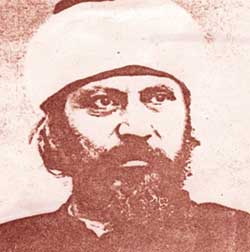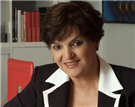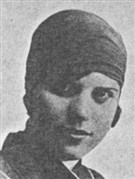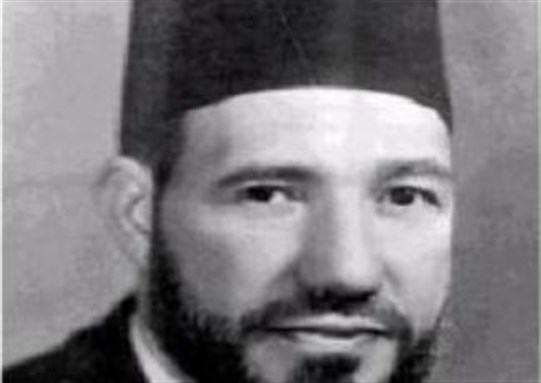[”A Profile from the Archives“ is a series published by Jadaliyya in both Arabic and English in cooperation with the Lebanese newspaper, Assafir. These profiles will feature iconic figures who left indelible marks in the politics and culture of the Middle East and North Africa. This profile was originally published in Arabic and was translated by Mazen Hakeem.]

Name: Sayyid Jamal ad-Din al-Afghani
Known As: Al-Husseini – His father is Safdar
Date of Birth: August 1838
Place of Birth: Asadabad (Afghanistan/Iran)
Profession: Primarily a politician, he was also a journalist and a public intellectual. He is considered one of the leading pioneers of the Islamic renaissance and the school of reform and renewal.
Jamal ad-Din al-Afghani
- Well versed in Arabic, he studied Sharia law and Sufism. He was also familiar with other fields, such as logic, philosophy, and mathematics.
- Historians and intellectuals differed regarding his place of birth and the place where he received his religious education. This is of great importance especially because he was an activist in Sunni Muslim countries. Documents prove that he received his education in the Caspian region and Tehran and then later, in Karbala and Najaf, thereby predominantly Shiite religious centers. His contemporaries and students, including Muhammed Abduh and Rashid Rida, state that al-Afghani received his religious education in Afghanistan, which is mostly Sunni, and therefore belonged to the Sunni sect.
- Some historians argue that al-Afghani hid his place of birth to conceal his Shiite origin in order not to raise suspicion by Sunni scholars of his ideas and calls.
- Spent his life traveling between India, Afghanistan, Egypt, Astana, Paris, and London.
- Worked as a politician and a journalist in a period that allowed historians to trace and document his life. al-Afghani is considered one of the pioneers of Islamic renaissance. He called for renewal in Islamic thinking, especially when he resided in Egypt where he sought to spread his ideas through journalistic work, lessons, and lectures. He was given the title "Wise Man of the East," and Arab sources often refer to him as "Al-Sayyed."
- Affiliated with the Freemasonry in 1875 and appointed head of the Star of the East Lodge three years after his affiliation. He is assumed to have attempted recruiting many of his students and followers in Egypt and Iran into Freemasonry.
His Life
- During his career, al-Afghani could not stay in one place for an extended period of time, except for Egypt where he stayed for eight years. This is the longest period of time on record starting in 1866 when his travels and activities were tracked.
- Historians were not able to trace al-Afghani’s life and accomplishments until 1866 when he first appeared in Kandahar, Afghanistan where he served as special counselor for Prince Muhammad A’zam from 1866 to 1868. It is said that al-Afghani introduced himself as the Istanbulite. His service at Prince A’zam Khan’s court ended when the latter was defeated by his brother Sher Ali and fled to Iran. Sher Ali banished al-Afghani from Afghanistan in 1868.
- Moved to Egypt passing through India, and then to Astana. He reached the Ottoman Caliphate headquarters in 1870. There, he delivered a speech encouraging industrialization comparing it to body parts. He then said in his speech: “There is no life for a body without a soul. The soul of this body is either prophecy or wisdom.” His sentence was used against him and Islam Sheikh Hasan Fahmi Afandi accused him of comparing the prophecy to industries or crafts as these things are acquired. This incident upset Sunni scholars and forced him to leave Astana in 1871 and head for Egypt.
- In Egypt, al-Afghani stayed for eight years from 1871 to 1879. During this time, he was active in journalism, politics, and science. He gave many lessons and lectures to the public and was able to attract many students and followers, including Muhammed Abduh, also know as Sheikh Imam, and Saad Pasha Zaghloul who later became the leader of Al-Wafd Party. His activities were not limited to lectures and lessons, as he wrote in a few Egyptian newspapers like Misr under the editorship of Adib Isaac and Imra`at al-sharq (Woman of the East) that was published by Ibrahim al-Laqani. al-Afghani’s ideas and his call for renewal did not go down well with the sheikhs and scholars of Al-Azhar and they accused him of atheism and heresy.
- What distinguished his political activity was that it was primarily focused against British colonialism. It seems he incited his followers against Khedive Ismail, although al-Afghani was on good terms with his successor Muhammed Tewfik Pasha. However, the latter got suspicious over al-Afghani’s intention, so he banished him from Egypt in 1879.
- From Egypt he went to India and lived there between Hyderabad and Calcutta. He wrote his famous book Al-Radd `ala al-Dahriyyi (Refutation of the Materialists), which was translated from Persian to Arabic by his student Muhammed Abduh.
- In 1883, he traveled from India to Paris and stayed there for more than three years. During that time he issued Al-`orwah al-wuthqa (The Most Trustworthy Handhold) magazine which he edited along with his student Muhammed Abduh. They were assisted by Muhammad Baqir Al-Bowanati from London. Eighteen editions of The Most Trustworthy Handhold were published, in which he mostly denounced British occupation.
- The debate between him and the French orientalist Ernest Renan was the reason behind his wide fame in Western circles in addition to the East. The debate with Renan revolved around the standing towards science in Islam. Renan gave a lecture in which he ascribed the deterioration and stagnancy in the Arab world to Islam. Renan also acknowledged the superiority of the Aryan race over the Semitic race, and indicated that the Arab element in these “Arab sciences” was merely the language and nothing else. As for the philosophers themselves who were famous at the time, they were Levantine Christians, Persians, or Andalusian.
- al-Afghani replied to Renan in a tactful and a dialectical manner, refuting these positions. He presented a comparison between what Renan referred to as Islam’s role in suppressing and strangling sciences and what Christianity did to its philosophers and scientists. al-Afghani admitted that humans are subjected to enslavement and contempt when they surrender themselves to the men of knowledge of their people. They obey them, follow their instructions, and succumb to their orders, while those men prohibit any argument regarding good and evil. However, in the same sentence, he generalized this phenomenon rendering it not exclusive to Islam alone but also to a part of Christianity and even paganism.
- In his reply, al-Afghani wrote that Islamic religion is no different than other religions in its built-in intolerance. The Islamic community has not gotten rid of the custody of religion. However, he was hopeful that the Islamic nation will break free and proceed on the civil road with its head high up just like the West.
- While this debate led to al-Afghani`s fame in the West and him being considered a pioneer in the renewal and reform school, it also led to more divisions surrounding his religious and dogmatic approaches. Translators of this debate omitted some parts of al-Afghani’s responses because they deemed what he said about Islam as inappropriate.
- In 1884, Naser al-Din Shah Qajar, the Iranian Shah, invited him to Iran to head military affairs. al-Afghani accepted the post, however, the Shah became apprehensive, fearful, and got suspicious. He eventually banished him to Russia where he became active in anti-British journalism. He stayed in Russia until 1889.
- Returned to Iran in 1889, and became the special counselor for Shah Naser al-Din, until suspicion crept once again and the Shah banished him once more in 1891.
- Throughout his stay in Basra, and later on in London, al-Afghani devoted his energy to incite his followers to rise up against and overthrow the Shah. He edited many articles in Diya` al-Khafiqain magazine in London and attacked the Shah`s pro-British policies, especially the tobacco franchise that the Shah granted the British.
- Received an invitation from Sultan Abdul Hamid II to come to Istanbul, so he traveled there in 1892 and stayed there until he died of oral cancer in 1897.
His Works
al-Afghani did not leave many written works except for his book Al-Radd `ala al-Dahriyyi (Refutation of the Materialists), which was written in Persian during his stay in Hyderabad; and a short book called The Complete Statement of Afghanistan History tatimmat al-bayan fi tareekh al-afghan, which was published in Egypt. His students kept record of some of his lectures as he did not write them down.
His journalistic works were more abundant as he was active in many journals in Egypt and Russian in addition to The Most Trustworthy Handhold magazine, in which he edited articles along with Muhammed Abduh as well as Diaa Al-Khafiqain newspaper in London.
His Ideas
- As seen by his followers, al-Afghani drew attention to separating illusions from thinking. He called upon his students to work in writing and creating literary, wisdom and religious seminars. He worked on lifting up the Islamic State from its weakness to the ranks of developed nations where Islam is of significant importance. He saw that the sciences had a very important role.
- Put forward an idea of establishing a university that includes all the Middle Eastern countries and drives these countries against colonialism, especially British colonialism. Critics of his works differed if al-Afghani meant an Islamic University that includes only Muslim countries or a Middle Eastern university that includes all the Middle Eastern countries that were subjugated to Western colonialism.
- al-Afghani drew the attention of many intellects, politicians and writers from an early stage. Many books were published that analyzed his ideas and political approaches since the beginning of the previous century. Professor Edward Brown issued a book called The Persian Revolution of 1905–1909 (1910) where al-Afghani was one of the main characters. Sheikh Muhammad Al-Makhzoomi wrote a book called Khatirat Jamal ad-Din al-Afghani (The memoirs of Jamal ad-Din al-Afghani) where he presented a detailed overview on al-Afghani’s life. He justified and defended his political ideas and views.
- al-Afghani is still the subject of controversy among intellects and historians, both Arab or Westerners, and also among followers of various religious trends. There are some who support al-Afghani’s ideas and views. They see in them the renewal that the Islamic nation needs in order to rise up and resist colonialism. These supporters see that al-Afghani strived to awaken the awareness revolution in people and the potential spirit in the Middle Eastern people. He devoted his life to fighting despair and foreign influence in addition to relying on the Qur`an as a platform to building individuals and communities. On the other hand, there are some who sought to oppose his ideas and prove them wrong, suggesting his bad faith. A polarizing figure, al-Afghani was seen by some as suspicious due to ongoing arguments around his origins and the schools in which he acquired his education. Many articles attempted to prove that he was a Shiite, Baha’i, or even atheist.
Further Reading:
![[Jamal ad-Din al-Afghani]](https://kms.jadaliyya.com/Images/357x383xo/afghani2.jpg)













.jpg)




